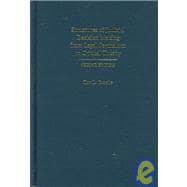
Note: Supplemental materials are not guaranteed with Rental or Used book purchases.
Purchase Benefits
What is included with this book?
| Traditional process | |
| Legal formalism | p. 37 |
| Scalian textualism | p. 61 |
| Legal realism | p. 89 |
| Sociological jurisprudence | p. 111 |
| Legal process | p. 133 |
| Philosophical foundations | p. 157 |
| Levels of judicial analysis | p. 169 |
| Critical process | |
| Critical theory : central element | p. 193 |
| Critical theory : operational elements | p. 229 |
| Structure of critical process | p. 259 |
| In re Kulko v. Superior Court | p. 269 |
| In re Brown v. Board of Education | p. 283 |
| Table of Contents provided by Blackwell. All Rights Reserved. |
The New copy of this book will include any supplemental materials advertised. Please check the title of the book to determine if it should include any access cards, study guides, lab manuals, CDs, etc.
The Used, Rental and eBook copies of this book are not guaranteed to include any supplemental materials. Typically, only the book itself is included. This is true even if the title states it includes any access cards, study guides, lab manuals, CDs, etc.